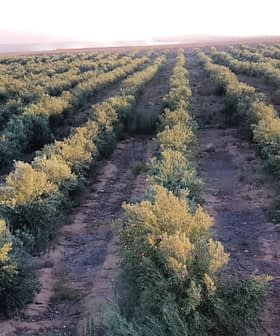Olive Cultivation Is Expanding in Georgia

Olive growing in Georgia has expanded to 1,200 hectares and will continue to grow, local experts told the recent International Olive Council (IOC) meeting in Tbilisi.
They added that Georgian olive growers are working with imported varieties and evaluating local ones as they plot the sector’s future.
In such a relevant moment for olive growing expansion, it has been crucial to choose the correct varieties. We need them to be capable of overcoming cold winters and suitable for the specific farming practices of the region.
“Georgia aspires to be one of the key players in the South Caucasus olive sector,” said Abdellatif Ghedira, the IOC’s executive director.
According to data from Juan Vilar Strategic Consultants, Georgia produces about 900 tons of olive oil and 500 tons of table olives per annum.
See Also:Global Olive Oil Production Will Reach 4.4M Tons by 2050, Expert ProjectsOne of the somewhat surprising drivers that may help Georgia speed up its current strategy of olive grove expansion is climate change, as more of the country becomes amenable to olive cultivation.
“In several areas, projections show that the number of warmer days will increase,” Zviad Bobokashvili, head of the department of fruit crop research at the Ministry of Agriculture, told Olive Oil Times. “In contrast, we expect a reduction in critical winter temperatures, and it could be possible that olive production will expand in even more areas.”
About 95 percent of the new groves are likely to be located in Kakheti, a central-south eastern region, where average temperatures have risen more rapidly in the last 40 years than in the rest of the country.
However, climate change also provides plenty of challenges for Georgian farmers and olive growers.
“For sure, there are, and there will be negative impacts, such as lack of rainfall during summer months which could lead to an irrigation deficit of olive plantations, impacting quality and yields,” Bobokashvili said.
Other challenges come from an increased risk of hail damage to the trees, which is also linked to rising temperatures. Higher temperatures may also facilitate the spread of disease and pests.
“All of this will require more integrated plant protection measures,” Bobokashvili said.
Despite its small size – Georgia covers less than 70,000 square kilometers with forests covering 33 percent of this total – the country comprises varied farmlands defined by the mountainous terrain and plenty of water resources. However, not every area that is amenable to olive cultivation will be able to rely on irrigation.
“Some olive trees have been planted in areas where they are experiencing a lack of irrigation in the summer,” Bobokashvili said. “But the goal of the new projects is to plant olive groves in areas suited to perennial crop production.”
“This strategy will give farmers the option to diversify existing crops and to establish production for a sector which is still in its early stages of development in Georgia,” he added.
Georgian agricultural experts said effective adaptation to climate change will require new water wells and irrigation systems, including drip irrigation networks, to withstand water shortages. New monitoring tools will also be needed to predict and analyze the spread of pathogens.
However, Georgian farmers will work to mitigate these challenges by using the best farming techniques, such as windbreak lines and new mulching technologies to maintain moisture in the soil.
“We can already count on a complete and modernized production chain, as our olive processing facilities are up to date and already produce extra virgin olive oil from local groves,” Bobokashvili said.
With IOC support, new expert training opportunities will help improve the efficiency of harvesting and transforming olives.
Bobokashvili said that to withstand the cold Georgian winters and boost the expansion of olive growing, farmers have mostly adopted two olive cultivars imported from Turkey: Gemlick, which is traditionally used for black table olive production, and Ayvalik, or Edremit, which is mostly grown in northern Turkey.
“In such a relevant moment for olive growing expansion, it has been crucial to choose the correct varieties,” Bobokashvili said. “We need them to be capable of overcoming cold winters and suitable for the specific farming practices of the region, such as copper spraying in autumn and reduced nitrogen fertilization.”
Planting several Italian cultivars capable of coping with cold climates, such as Ghiacciola, Frantoio, Correggiolo, Leccino and Ascolana, may also help Georgian farmers expand production.
Additional research is underway to determine whether Arbequina and Koroneikli – both of which grow in high-density groves – would be suitable in Georgia.
The future of olive growing in the country will also be built on its historic roots, as researchers hope to incorporate at least some of the ancient cultivars that used to dot the countryside into the current production matrix.
According to legend, olive trees were first brought to Georgia and neighboring Armenia by Noah. However, scientific evidence shows the first evidence of olive trees in the region dating back to the 1st or 2nd century C.E., when olive trees are believed to have been imported from Greece.
Since their introduction, olive trees have become part of the culture, with both table olives and olive oil featuring prominently in local cuisine and traditional medicine. However, harsh Georgian winters have led to many years in which olive trees were severely damaged.
Despite these obstacles, experts believe that cultivars such as Oturi, Butko, Gorvala and Tbilisuri have been grown by locals sporadically for centuries.
“At the moment, these ancient cultivars are yet to be examined but preliminary explorations in west Georgia have found very old olive trees that will need to be identified,” Bobokashvili said. “The goal is to examine them and propagate these trees.”
“The scientists are also working to introduce new varieties and investigate the feasibility of new high-density groves,” he added.









